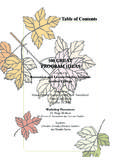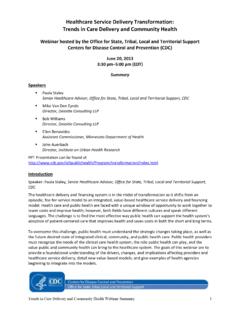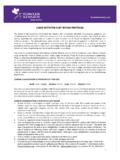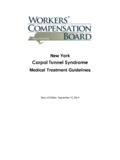Transcription of Aging and Driving:Ontario’s Licence Renewal Program for ...
1 1 Aging and driving : ontario s Licence Renewal Program for Drivers Age 80 and Above(Supplemental Reading)2 Table of Contents1. Introduction 32. Strengths of Senior Drivers Age 80+ 33. The Effects of Getting Older on driving 44. Medications and driving 85. Good Practices to Maintain driving Fitness 126. driving Habits Checklist 137. The Safety driving Cycle 198. High-Risk driving Situations 209. The Importance of Signs 2410. Alternatives to driving 2711. Closing Reminders 2912. More Information 3031. IntroductionWelcome to the ontario Ministry of Transportation s Group Educational Session for senior drivers. The goals of this session are to: To promote road safety Build on your strengths as senior drivers Talk about the effects of getting older on driving Provide information about the effects of medication on driving Help you deal with traffic situations of special concern Review some rules of the road and traffic signs Help you drive safely for as long as possible, but also Help you decide when it is time to limit or stop driving Judgment The best judgment comes with experience.
2 History is full of leaders that made their best contributions later in life. Many current world leaders are in their 60s and older. Experience - Seniors have a wealth of experience. By the time we reach 80, most of us have been driving for years, on all kinds of roads and in all kinds of situations. Knowledge Seniors have accumulated tremendous knowledge over their driving careers about road safety and good driving practices. Vitality - Seniors are now living longer, healthier and more active Strengths of Senior Drivers Age 80+Purpose4 Responsible - As a group, seniors are quite responsible. Seniors have a low rate of drinking and driving and other risky driving behaviours such as speeding when compared to drivers in other age categories. Ability to Adapt - Seniors have shown they can adapt to the many changes that have occurred in roads and motor vehicles over the years. Many seniors also make changes in their driving habits ( , choosing not to drive at night, in bad weather or in heavy traffic).
3 This ability to adapt is very important as we experience the effects of getting The Effects of Getting Older on DrivingWe all have different abilities and skills as drivers. All drivers need to be aware of both their strengths and limitations in order to make good decisions (such as when and where to drive).While we age at different rates, we all experience some changes in our bodies as we get older. This means that even small age-related changes can make a big difference in driving decisions and subsequently, can affect road safety. It is important to be self -aware and identify the types of changes that could influence your ability to drive safely. Knowing more about how Aging affects driving is the first step in keeping you on the road part of the Booklet provides an overview of the most common and important types of changes associated with Aging that can affect your driving ability ( , vision, flexibility/movement/strength, and other changes such as reaction time and concentration and cognitive impairments).
4 The important thing is to know your own level of you know that drivers often must make 8 to 12 decisions every kilometre or half mile? Sometimes, you have less than half a second to make a Yourself5 VisionYour vision is tested when you renew your driver s Licence to make sure it meets driving standards. If you are having any of these problems, see your conditions can also affect vision. Cataracts are like having a waterfall in front of your eyes, and can seriously affect your ability to drive. The good news is the problem can now be easily eye disorders that can lead to reduced vision or even blindness are glaucoma and macular degeneration (loss of sharp central vision). These disorders become prevalent in adults over the age of 60. Glaucoma, if detected early, can be effectively treated, in most cases. There are new and effective treatments for many people with macular degeneration. Those with diabetes may also experience vision changes on account of the disorder.
5 Regular eye exams can detect these changes in vision as we age may lead to problems: Seeing moving objects Seeing less clearly (especially at night or at dusk and dawn) Judging distance Being more sensitive to glare (such as rain and light on the windshield)Did you know, by age 75, almost half of us will have early cataracts, and about one in four will have advanced cataract , Movement and StrengthBy age 65, one-third of us have some hearing loss. Gradual hearing loss increases with age. Medical problems (such as tinnitus or ringing in the ears and infections) can also impair hearing. Regular hearing exams can pick up these problems. The good news is that better hearing aids are being developed all the we age, we often have more stiffness and less range of movement in our neck, shoulders, arms, legs and trunk. Similar to flexibility or movement, strength also tends to decrease with age, especially if people are not physically active.
6 If you lack flexibility, movement and strength in your limbs or joints, it could affect your ability to affects our ability to: Check your blind spot Look for traffic and pedestrians at intersections Merge with oncoming traffic Yield the right of way, back up and parkHearing loss affects one s ability to hear horns, sirens and brakes. You may also have to rely on your vision more to compensate for hearing good news is exercises and stretching can improve flexibility, muscle strength and range of motion . Talk to your doctor about becoming more , you need to turn your head or body to check your blind spot and to see what is around Time and ConcentrationMany people develop some arthritis with age. Osteoarthritis, the most common form of arthritis (which affects 1 in 10 adult Canadians), affects the body s joints causing swelling and pain. Rheumatoid arthritis is less common, but more painful. Both forms of arthritis can restrict movement.
7 Osteoporosis (bone disease) also makes moving more difficult and painful. Other conditions such as fibromyalgia, lupus and gout can also limit your flexibility, movement and weakness or muscle stiffness can make it difficult for you to drive. For example, arm strength is important for the safe control of your steering wheel, particularly when you have to make quick or sudden movements. Leg strength is important for pressing your acceleration and brake pedals, especially when quick actions are problems such as Parkinson s Disease, stroke, Lou Gehrig s Disease, tremors and muscle spasms can limit coordination making it difficult to respond to sudden events on the impairmentsSenior drivers are at an increased risk of suffering from late-life cognitive impairment and dementia. Dementia affects the brain and the ability to think, remember, and speak. It impairs a person s logical reasoning, memory, and their language skills.
8 Nearly 10% of Canadians over the age of 65 have dementia; the disease increases crash risk by up to times. Drivers with dementia are likely to commit unsafe driving maneuvers such as improper turning or following too close). Mild cognitive impairments can be difficult to detect. Those who have them typically suffer greater memory problems than others of the same age. But these mild impairments can develop into dementia or Alzheimer s, typically within five years, sometimes in a shorter period. With age, we may also experience gradual changes in: Reaction or response time (slower) Concentration (more easily distracted), and Coordination (poorer)84. Medications and driving Drowsiness Dizziness Blurred vision Difficulty concentrating and staying awake Confusion Memory lapses Difficulty keeping a steady course (staying in the proper lane)Seniors need to be cautious about taking medications and age 80 and above tend to take more medications than other age groups.
9 It is not uncommon for seniors to have multiple prescriptions 1/3 of adults 65 and older take five or more prescriptions! Some medications (both prescription and over-the-counter) have side effects that could make driving unsafe so it is important to be cautious. The risk of side effects and interactions increase with the number of medications taken. One medication may not impair driving , but combinations of medications could. Alcohol mixed with certain medications can also be very dangerous. With age, our bodies react differently. It takes longer for the body to break down or get rid of medication. Medical problems can also alter the body s response to certain medications. It is always a good idea to discuss not only physical changes with your doctor, but also cognitive symptoms can make it difficult to stay in the proper lane, maintain appropriate speed, maintain a safe following distance, react to road signs, and respond quickly (braking or swerving to avoid a collision).
10 Any medication that impairs the central nervous system (brain and spinal cord) could potentially make driving unsafe. Certain medications are likely to cause the above symptoms and affect driving ability. These can include: Tranquilizers and sedatives Anti-depression and anti-anxiety medications Narcotics (medication for pain) Muscle relaxants Sedating antihistamines (for allergies and hay fever) Cold and flu medications Possible effects of medication on driving :Some of these medications are available over-the-counter or could be natural or herbal remedies. It is important to remember that non-prescription medications can also have side effects that make driving you have any of these symptoms, you should not drive. Wait until you feel better, take a taxi or get someone to drive you. If you develop any of these side effects while driving , pull over and rest. Tell your doctor. Drowsiness/sleepiness Confusion and difficulty concentrating Dizziness/light-headedness Blurred vision Tremors Slowed reaction time Memory lapses10 Talk to your doctor and pharmacist Make a list of all the medications you take.



















